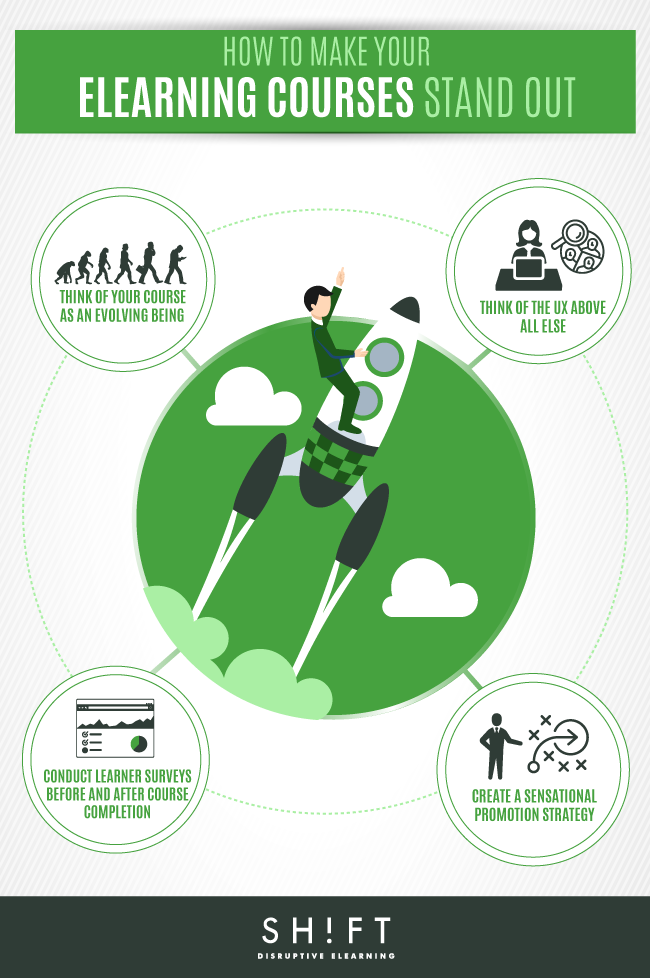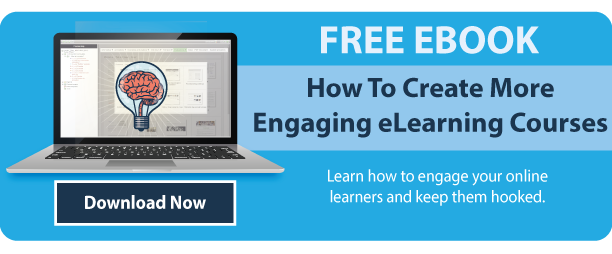eLearning is a disruptive technology, changing the way people acquire education. From online schools to on-the-job training, learning via electronic means is becoming the norm. With this in mind, realize that even though you may have highly valuable information to share with learners, your competition is growing each day.
Use this guide to help you ensure that your eLearning courses stand out from the crowd of ever-evolving electronic learning opportunities.

1) Think of Your Course as an Evolving Being
You know that your eLearning project consists of a series of informational suggestions for your learners to take value from. Have you considered the fact that not everything students take away from your class may be valid in a year from now? The information age has brought about a time for constant development of knowledge, standard procedures, and useful tools in most fields of expertise. What is standard today, even if it has been the paradigm for the last decade, could change in the blink of an eye. Your course should be evergreen and viewed more as a helpful encyclopedia than a book that only gets read once.
Following-up with each student about updates to course information or industry shifts may sound like a hassle, but it doesn’t have to be. With modern tools, you can automate the process of keeping your learners involved. There are several means of automation that help keep your course alive, even after completion.http://ctt.ec/7R0nr
- An email newsletter is a new media marketing necessity that you should already be implementing. It is also one of the easiest ways to automate the delivery of course updates to previous students, especially when the updates are already being sent to current learners.
- Customer relationship management software is a great tool for anyone with an online project involving relationships with consumers. These platforms help professionals and teams keep track of business-related communications, helping close sales and offer better customer service. They can also be helpful when considering the needs of past learners.
- Automation tools provided by your instruction platform can also be looked at. Put anything to work that makes automation easy. Do what you can to maintain relationships with students, both future and past.
Your learners are evolving beings, and your course should mirror that trait to maintain an ongoing relationship with them. Tweet this.
2) Conduct Learner Surveys Before and After Course Completion
It is common knowledge that adult learners want to be involved in their learning process. By delivering an introductory survey, you give them the opportunity to let you know what they expect to learn from your course and how they plan to apply it in their everyday life. Not only does this involve the students in the process, but it gives you valuable insight into how you can best deliver your intended message.
Once the course is over, ask students to evaluate you for further insight. You can take what you learn from an exit survey and make changes to the next course as well as follow-up for previous students. Your eLearners are going to be your best allies when it comes to building a class with high ratings and strong retention.
3) Think of the UX Above All Else
Great online courses focus on UX above all else, and you should be too. For example, many people browse the web mostly from a smartphone or tablet, rather than a PC. If you provide your learners with an app for easy access, they are likely to find your course more convenient.
In some cases, you won’t be able to provide learners with an Android or iOS app for all eLearning needs, especially when your course will require a lot of writing or something else that is more easily accomplished on a laptop or PC. The trick here is not to implement the convenience tools that will work best for the majority, but which ones will work best for your students. If you are teaching a course on sound design, with Pro Tools projects as your main focus, an app for the Mac Desktop might be worth looking into.
Your learners are the only ones who know what they really want, and you are free to ask them. You may be able, with the right research, to find forums where learners like yours are already discussing what they want. Find out what problems your learners face and try to solve them; it’s the simplest formula for UX success.
4) Create a Sensational Promotion Strategy
If you’re a teacher by trade, it might be time to call in the help of a marketing professional. You can ask for a consultation or even find a freelancer or agency to write you up a promotional strategy. If it’s in your budget, hiring someone to implement your strategy might not be a bad idea. Getting the word out about your course is key, and if you’re going to do it yourself, here are some basic steps to follow:
- Set a promotional goal.
- Research your audience.
- Decide how you will measure success.
- Choose which platforms to share on.
- Detail a plan for advertising your course (leave room for analysis and adjustments along the way).
- Implement your strategy.
- Analyze and adjust based on need.
Promotional Tips for eLearning Courses: Before prospective students ever start your course, ensure that they know about the follow-up information that you or your organization will provide. Inform them of newsletters and free downloads that they have access to now. If you’re on social media, invite learners to connect with you. Don’t forget to let people know what makes you unique, how your course is different from all the others.
Also read: Here's How To Promote Your New eLearning Program Internally
About the author:
Florence Mendoza is a former educator and an eLearning specialist. She currently works at http://www.buyanessay.com/ writing company.


